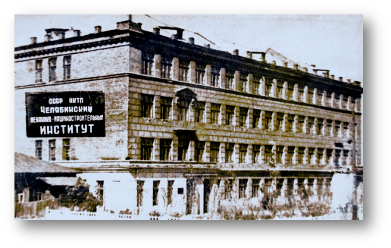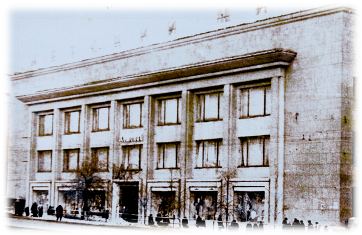Before the meteoric rise: establishment of the university and foundation of university traditions
1943 is the year of the university’s establishment. During the war, the largest tank production complex Tankograd was created in Chelyabinsk, which included 4 enterprises: the Kirov plant, the Chelyabinsk and Stalingrad tractor plants, and the Kharkov motor plant. In such a structure it had been functioning from October 6, 1941 to June 20, 1958.
At that time the training of engineers in Chelyabinsk was conducted at the Stalingrad Mechanical Institute, evacuated from Stalingrad. But after the victory of the USSR in the Battle of Stalingrad, the institute had to be returned back. Then it was decided to create in Chelyabinsk its own alma mater of workers and scientists.
On November 2, 1943, the Council of People's Commissars of the USSR adopted Decree No. 1201-361c “On Measures to Improve the Preparation of Engineering and Technical Specialists for Tank Industry Enterprises” and on the establishment of the Chelyabinsk Mechanical and Engineering Institute (CMEI). By inheritance, from the Stalingrad Mechanical Institute, CMEI received a few study rooms and senior students. Later they were joined by graduates of Chelyabinsk schools and Chelyabinsk residents, who had returned from the front line. In March 1944, a little more than 300 students were studying at the institute.
From the very beginning, the institute set a high standard of research life. The faculty staff was also distinguished by a high level: more than 40 teachers, including professors, doctors of sciences. At the time of establishment of the institute, there were 3 Doctors of Sciences among the faculty members: Nikolai Fedorovich Kunin (Doctor of Physical and Mathematical Sciences), Avraam Nakhimovich Rabinovich (Doctor of Technical Sciences), I. I. Chernobylsky (Doctor of Technical Sciences, corresponding member of the Ukrainian Academy of Sciences ), professor G.M. Gorodetsky (gave electrical engineering courses), Leningrad professor R.Z. Nesselstrauss (gave the course of metallurgical science), V.A. Dobrovolsky and others.
.png) |
The first director of the new educational institution, according to Order No. 1 d.d. December 15, 1943, was Petr Alekseevich Grishin, Ph.D. in technical sciences, and the head of the “Cutting of metals and artillery manufature” department of the Stalingrad Mechanical Institute. He had to solve the problems associated with the establishment of a new university. |
 |
From 1944 to 1947, Nikolai Leonidovich Dukhov, Doctor of Technical Sciences, chief engineer of armored vehicles, nuclear and thermonuclear weapons, three times Hero of Socialist Labor, awardee of the Lenin and State Prizes, and the first head of “Armored fighting vehicles” department (1944-1947) was working at CMEI. Over the years of working at ChTZ, he set up a line-conveyor production of KV series tanks (“Klim Voroshilov”), led the development of self-propelled artillery systems and heavy tanks IS (Iosef Stalin), modified T-34 tanks, developed a new tractor ChTZ “Stalinets-80” with enclosed cabin. Dukhov was appointed as a head of tank construction department and a head of the State Examination Commission of CMEI. |
 |
Mikhail Fedorovich Balzhi – a close companion and successor of N.L. Dukhov, deputy chief engineer for serial production of tanks, and then - chief structural engineer of a special design bureau. During his management at the department of “Armored fighting vehicles” the well-equipped educational and scientific facilities were established, he formed a team of highly qualified teachers as well. In addition, a scientific school on inertial infinitely variable transmission was created, which was included in the history of the national technical science as the Balzhi School. Since 1965, Mikhail Fedorovich - Doctor of Technical Sciences, Professor. Until 1970 he was the dean of the “Automotive engineering” faculty. The idea of creating a new tank IS-3 (“Pobeda”/ “Victory”) belongs to Balhzi. He also designed tractors “Stalinets-65” and “Stalinets-80”, artillery tractor C-2. |
 |
An important role in the establishment of the university was played by the deputy director for scientific and educational work Avraam Nakhimovich Rabinovich - professor, doctor of technical sciences, the founder of the science of computer-aided manufacturing in machine building. He wrote more than 300 scientific works, 40 monographs and textbooks, received more than 120 copyright certificates of inventions, a significant part of which was implemented in the production. |
 |
Another outstanding personality, standing at the roots of the establishment of the university - Iosef Yakovlevich Kotin - Doctor of Technical Sciences, a designer of tanks and tractors, director of the pilot plant, where the design projects were implemented, the Colonel-General of the engineering and technical service, the Hero of Socialist Labor. In 1943 I.Ya. Kotin supported the idea of creating an institute, became a member of the Academic Council, mastered graduation papers for students of the CMEI. He headed the work on the creation of heavy tanks KV, IS, artillery mounts SU. |
Scientific staff of the University provided diligent assistance to various enterprises: the Kirov plant, the Miass automobile plant, the Chelyabinsk abrasive, electrode, and metallurgical plants. In turn, enterprises supplied the university with specialists. Kirov plant of people’s commissariat of armored manufacture by order of its director Isaak Moiseevich Zaltsman supplied the institute with qualified engineers-teachers, students with laboratories and workshops for practical and laboratory work, provided two dormitories (according to protocol No. 306 of the Bureau of the Chelyabinsk Regional Committee of the AUCP (b.) d.d February 19, 1944). The authorities of Kirov Tank Plant - I.M. Zaltsman, I.Ya. Kotin, N.L. Dukhov - were fully included into the Academic Council of CMEI in 1945.

How the university looked like in the first years of its existence? In 1943-1944 the institute was located in different parts of the city: in the building of school No. 4 near the railway station, in one of the schools of Traktorozavodsky district. Later, when the re-evacuation began, the institute was located in a three-story building of the store along Spartak Street (today - Leninsky Prospekt), where the “Detskiy Mir” store is located. In 1945, with the help of the Kirov Plant and the Chelyabinsk Regional Committee of the AUCP (b), the institute received a new building on Timiryazev Street (today - Lyceum No. 11), but this did not solve the problem of lack of training areas.
 In April 1944, at a meeting of the Bureau of the Chelyabinsk Regional Committee, it was established that the work on the development of the new university was unsatisfactory. The Institute was at a risk of closure. What to say: at the beginning students literally had nothing to sit on and nowhere to live - there were no dormitories. The lack of training facilities, equipment and laboratories was not the only problem of those years.
In April 1944, at a meeting of the Bureau of the Chelyabinsk Regional Committee, it was established that the work on the development of the new university was unsatisfactory. The Institute was at a risk of closure. What to say: at the beginning students literally had nothing to sit on and nowhere to live - there were no dormitories. The lack of training facilities, equipment and laboratories was not the only problem of those years.
There were difficulties connected with the management of the educational process: the teachers had to combine pedagogical activity and work in production, which was not easy. Students had to work as well. However, thanks to the efforts of the teaching staff and the enthusiasm of the students themselves, the situation quickly changed. In September 1944, summing up the results of the first academic year, the Council of the Institute concludes that “in all adverse circumstances, the classes did not stop for a single day, the examination session passed, basically satisfactorily, the student and teaching staff were retained, and the CMEI joined the ranks of the operating machine-building universities of the USSR”.
From the first years of its existence, CMEI began to be engaged in research work in the field of mechanical engineering. This was a requirement of wartime: the country needed technologies and people capable of controlling this technique. Already in June 1944 the State Examination Commission carried out the defense of the first diploma projects of students S.P. Pavlov (the topic “Designing a machine assembly department for the manufacture of IS tanks final drives” and A.P. Peskov. They were awarded “mechanical engineer” qualifications.
Initially, there were only two faculties in the Institute:
- Mechanics and technology (with such specialties as “Technology of mechanical engineering”, “Compression type machines”, “Pressure metal treatment”, “Welding machines”, “Welding production”),
- Armored fighting vehicles (with specialties “Tank production”, “Cars and tractors”, “Engines of internal combustion”). In 1944, the Armored fighting vehicles Faculty was renamed as the Faculty of Wheeled-Track Machines (KGM), in October 14, 1947 - as the Faculty of Automotive and Agricultural Machinery (ATS), and in 1949 it would finally become the Automotive engineering Faculty.
The tradition of holding scientific conferences is one of the first in the university. In May 1947 the first institute scientific and technical conference of teachers and employees was held at the CMEI, and in April 1948 the first student scientific and technical conference was organized.
From September 28, 1948 to April 1951, Mitrofan Markianovich Balyk, Ph.D., an assistant professor of the Aircraft production Department of the Moscow Aviation Institute, directed to Chelyabinsk by the order of the Minister of Higher Education, performed the duties of the CMEI director. On his initiative, there had been carried out the overhaul works of educational building and dormitories. In 1949, the Council of Voluntary Sports Society “Nauka” was established.
In the years of the national economy post-war reconstruction, the country required specialists of a new profile: machine builders, metallurgists, power engineers and builders. This affected the structure of the university – new faculties opened, the reorganization of CMEI began, which marked the beginning of a new stage in the development of the university.




